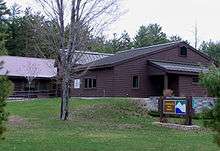Adirondack Park Agency

The Adirondack Park Agency (APA) was created in 1971 by New York Governor Nelson Rockefeller as a governmental agency that performs long-range planning for the future of the Adirondack Park. It oversees development plans of private land-owners as well as activities within the Adirondack Forest Preserve. Development by private owners must be reviewed to determine if their plan is compatible with the park. The agency is headquartered in Ray Brook, New York.
History
From its inception in 1892, the six-million-acre (24,000 km²) Adirondack Park, which is larger than Yellowstone, Yosemite, Grand Canyon, Great Smoky, and Everglades National Parks combined, has been a battleground between those who would preserve wilderness and proponents of the development rights of property owners. The Adirondack Park Agency was created in an attempt to settle many of these longstanding issues. It has been controversial from the outset.
The Adirondack Park is unique in that more than half of the land in the park is privately held. The APA was formed in response to a perceived threat to the integrity of the privately held portion, which, at the time, was in the hands of only a few hundred owners. The completion of the Adirondack Northway in 1967 drastically increased the pressure brought by developers for second home developments. The agency's first task was to create a master plan, followed by a zoning map and land use plan. This zoning map breaks the park up into different sections, and the land use that will be allowed on that particular piece of land is determined by the classification that it is given. The classifications are broken up into two sections, private land classification, and state land classification. Private land classifications are the most controversial because they determine what people can do on their own land. The different classifications for private land include hamlet, low-intensity use, moderate intensity use, rural use, resource management use, and industrial use. Citizens living in the park believe that much of the land is incorrectly classified. This is partly because the entire 6 million acres were classified in only eight months. A land classification can be changed through the APA, but it is a long process. Many argue that the whole map should be remade.
The land use plan, in particular, ignited a storm of controversy. The idea of non-residents from Albany and New York City dictating to residents of the park what they could and could not do with their own land caused a great deal of resentment among the traditionally independent-minded "Adirondackers". Anonymous phone calls threatened to burn the homes of APA members, truckloads of manure were dumped on agency land, a man was caught in the act of attempting to burn the new agency headquarters, and one town voted to secede from the park. While most park residents were opponents of the APA, some, notably Clarence Petty, supported it.
Initially, the APA handled matters poorly, and sentiment ran strongly against it. Then, in 1972, the Horizon Corporation of Tucson, Arizona, purchased 24,000 acres (97 km2) within the park and announced plans to build 10,000 new homes, along with golf courses, and ski areas. Other plans for 4,000 homes on 18,000 acres (73 km2) were under development. Suddenly the Park Agency's land use plan looked much more reasonable to many more people, and the continued existence of the agency assured.
The work of the APA remains controversial, however, with many of its actions drawing lawsuits from one side or the other. Recent issues have revolved around cell phone towers along the Northway and on Lake George, all-terrain vehicle and snowmobile access to park lands, floating camps and/or houseboats, and, as always, subdivisions. A number of organizations continue to monitor its actions, including the Adirondack Council, the Association for the Protection of the Adirondacks, the Residents' Committee to Protect the Adirondacks and the Adirondack Land Trust.
See also
Sources

- Angus, Christopher, The Extraordinary Adirondack Journey of Clarence Petty, Syracuse: Syracuse University Press, 2002. ISBN 0-8156-0741-5.
- McMartin, Barbara, Perspectives on the Adirondacks, Syracuse: Syracuse University Press, 2002. ISBN 0-8156-0742-3
- Zinser, Charles I., Economic Impact of the Adirondack Private Land Use and Development Plan, State University of New York Press, 1980. ISBN 978-0-87395-399-3.
"Maps & Geographic Information Systems (GIS)." Adirondack Park Agency Maps and GIS. NYS Adirondack Park Agency, 2003. Web. 21 Feb. 2014. <http://apa.ny.gov/gis/>.
External links
- Official site
- Visitor Information Centers
- New York Times, Building Boom in Adirondack Park Tests Laws to Preserve Wilderness", August 4, 1987.
- A Political History of the Adirondack Park and Forest Preserve Threats to Forever Wild